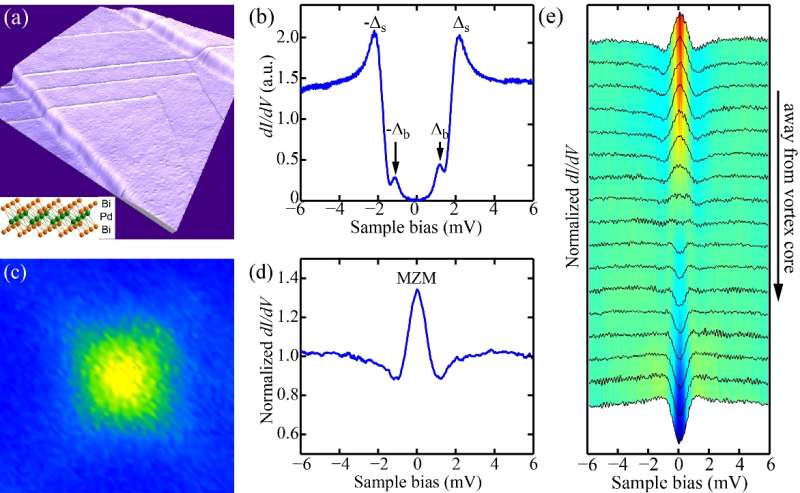Physicists demonstrate topological superconductivity on palladium dibismuthides

The search for Majorana fermions, particles that are their own anti-particles, in topological superconductors is of paramount importance in condensed matter physics today. Recently, a research team led by Professor Qi-Kun Xue of Tsinghua University in China has reported experimental evidence of topological superconductivity near the surface of epitaxial β-Bi2Pd films, and possible Majorana zero modes at magnetic vortices.
A topological superconductor is superconducting inside the bulk like other superconductors, while on the boundary/surface, it harbors the long-sought Majorana fermions. Such unusual particles obey non-Abelian braiding statistics and have potential for fault-tolerant quantum computing, which can theoretically operate more efficiently than current computers. A handful of topological superconductors have hitherto been proposed in topological insulators or other systems with strong spin-orbital coupling when they are interfaced with a superconductor or driven into superconducting states by chemical doping. However, little attention has been paid to searching for topologically nontrivial band structure in classical s-wave superconductors.
Tetragonal β-Bi2Pd was found to be superconducting below 5.4 K in 1957. Recently, angle-resolved photoemission spectroscopy has revealed that topologically protected surface bands cross the Fermi level of β-Bi2Pd. The two major criteria for realizing topological superconductivity exist within this single-component compound. Subsequent experimental searches for the buried topological superconductivity in β-Bi2Pd all fell flat. However, the researchers at Tsinghua University now report topologically nontrivial superconducting states in β-Bi2Pd.
"We are motivated to unravel why the topological superconductivity failed to be observed in all previous studies of β-Bi2Pd crystals, it is now known that tuning the chemical potential to isolate the topological surface states from bulk bands near the Fermi level is the key to observe such topologically nontrivial superconducting states," said Yanfeng Lv, the first author of this study, now is a postdoctoral researcher at Texas Center for Superconductivity, University of Houston.
Published in the journal of Science Bulletin, the study used a state-of-the-art molecular beam epitaxy technique under ultrahigh vacuum conditions to prepare high-quality β-Bi2Pd thin films on SrTiO3 substrates, which were then in-situ transferred to a cryogenic scanning tunneling microscopy chamber. The tunneling spectrum revealed a pronounced and impurity-resistant superconducting gap opening on the surface, which appears much larger than the bulk on owing to Dirac-fermion enhanced parity mixing of surface pair potential. The direct visualization of the superconducting gap opening on the topological surface states, as well as its expected variation with the Fermi level, compellingly reveals β-Bi2Pd as a promising candidate for topological superconductor. Salient zero bias conductance peaks, probably from Majorana zero modes supported by such superconducting states, were identified at the end of magnetic vortex lines.
"This research provides convincing evidence of topological superconductivity on β-Bi2Pd and the signature of Majorana zero modes at vortices," said the researchers, "and more importantly points to a novel avenue for searching topological pairing states on usual superconductors that might exhibit topologically nontrivial band structure by the engineering of Fermi level."
More information: Yan-Feng Lv et al, Experimental signature of topological superconductivity and Majorana zero modes on β-Bi 2 Pd thin films, Science Bulletin (2017). DOI: 10.1016/j.scib.2017.05.008
Provided by Science China Press




















